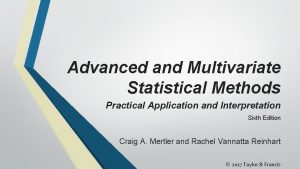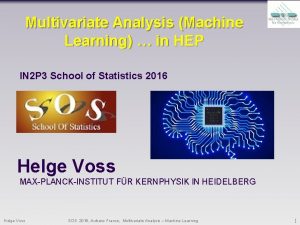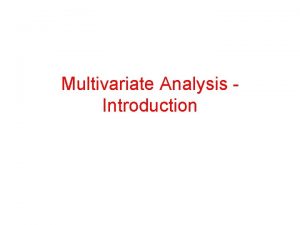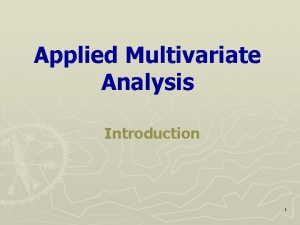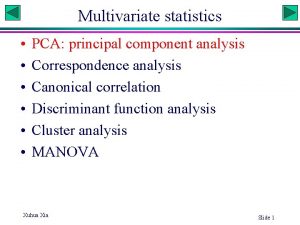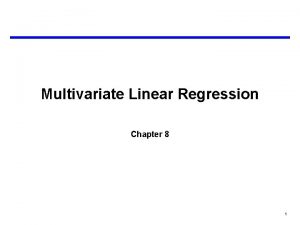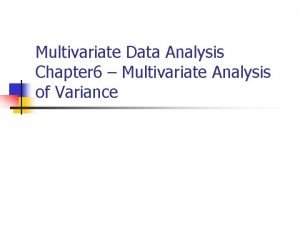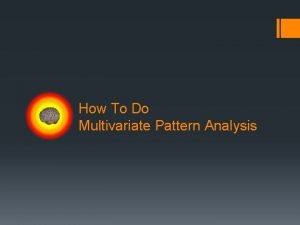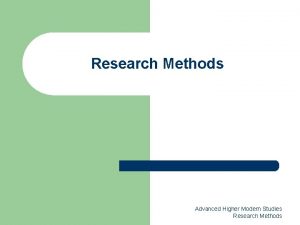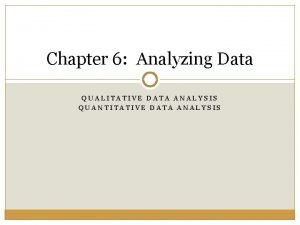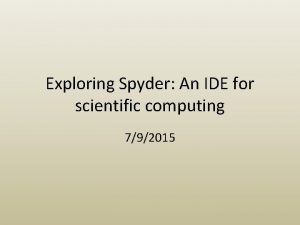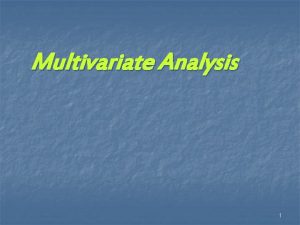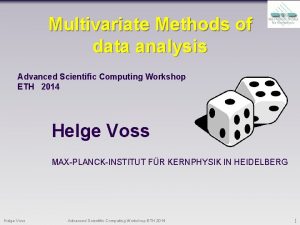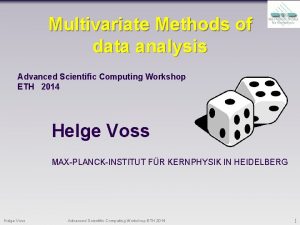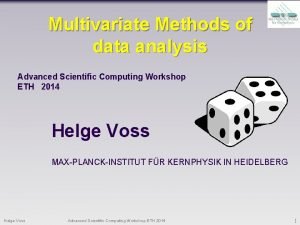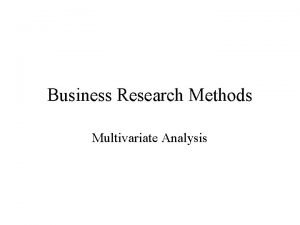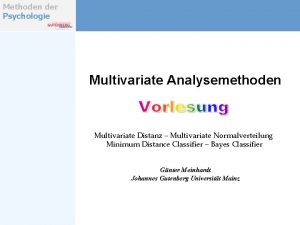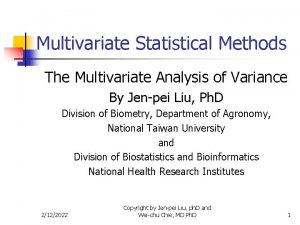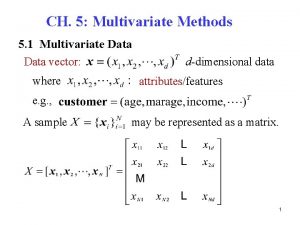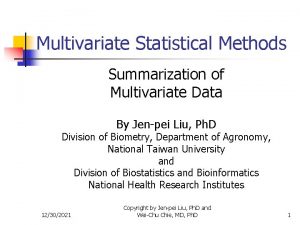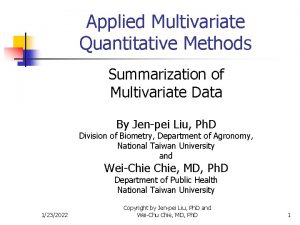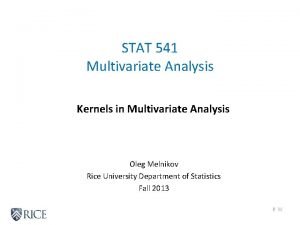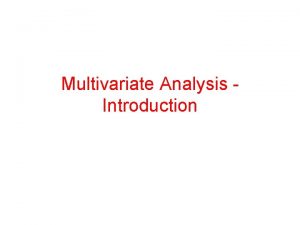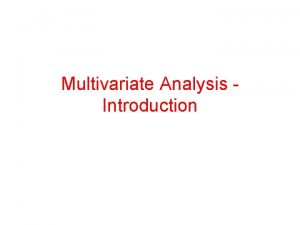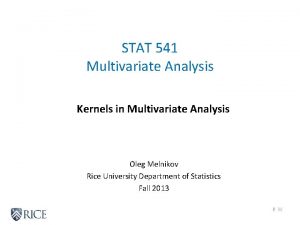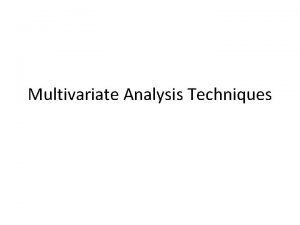Multivariate Methods of data analysis Advanced Scientific Computing


















- Slides: 18

Multivariate Methods of data analysis Advanced Scientific Computing Workshop ETH 2014 Helge Voss MAX-PLANCK-INSTITUT FÜR KERNPHYSIK IN HEIDELBERG Helge Voss Advanced Scientific Computing Workshop ETH 2014 1

Overview § Multivariate classification/regression algorithms (MVA) § what they are § how they work § Overview over some classifiers § Multidimensional Likelihood (k. NN : k-Nearest Neighbour) § Projective Likelihood (naïve Bayes) § Linear Classifier § Non linear Classifiers § Neural Networks § Boosted Decision Trees § Support Vector Machines § General comments about: § Overtraining Helge Voss § Systematic errors Advanced Scientific Computing Workshop ETH 2014 2

Event Classification § Unfortunately, the true probability densities functions are typically unknown: Neyman-Pearsons lemma doesn’t really help us directly § Monte Carlo simulation or in general cases: set of known (already classified) “events” § 2 different ways: Use these “training” events to: § estimate the functional form of p(x|C): (e. g. the differential cross section folded with the detector influences) from which the likelihood ratio can be obtained e. g. D-dimensional histogram, Kernel densitiy estimators, … (generative algorithms) § find a “discrimination function” y(x) and corresponding decision boundary (i. e. hyperplane* in the “feature space”: y(x) = const) that optimially separates signal from background e. g. Linear Discriminator, Neural Networks, … (discriminative algorithms) * hyperplane in the strict sense goes through the origin. Here I mean “affine set” to be precise Helge Voss Advanced Scientific Computing Workshop ETH 2014 3

K- Nearest Neighbour § estimate probability density P(x) in D-dimensional space: § The only thing at our disposal is our “training data” “events” distributed according to P(x) x 2 h § Say we want to know P(x) at “this” point “x” § One expects to find in a volume V around point “x” N*∫P(x)dx events from a dataset with N events “x” V § count #training events in volume V(h) K-events: x 1 estimate of average P(x) in the volume V: ∫P(x)dx = K/N V § Classification: Determine PDFS(x) and PDFB(x) likelihood ratio as classifier! Helge Voss Kernel Density estimator of the probability density Advanced Scientific Computing Workshop ETH 2014 4

K- Nearest Neighbour § estimate probability density P(x) in D-dimensional space: “events” distributed according to P(x) x 2 h § The only thing at our disposal is our “training data” § Say we want to know P(x) at “this” point “x” § One expects to find in a volume V around point “x” N*∫P(x)dx events from a dataset with N events “x” V § count #training events in volume V(h) K-events: x 1 estimate of average P(x) in the volume V: ∫P(x)dx = K/N V § Regression: particle) Helge Voss If each events with (x 1, x 2) carries a “function value” f(x 1, x 2) (e. g. energy of incident i. e. : the average function value Advanced Scientific Computing Workshop ETH 2014 5

K- Nearest Neighbour § estimate probability density P(x) in D-dimensional space: § The only thing at our disposal is our “training data” “events” distributed according to P(x) x 2 h § Say we want to know P(x) at “this” point “x” § One expects to find in a volume V around point “x” N*∫P(x)dx events from a dataset with N events “x” V § count #training events in volume V(h) K-events: x 1 § determine K from the “training data” with signal and background mixed together x 2 k. NN : k-Nearest Neighbours relative number events of the various classes amongst the k-nearest neighbours § Kernel Density Estimator: replace “window” by “smooth” kernel function weight events by distance (e. g. via Gaussian) Helge Voss Advanced Scientific Computing Workshop ETH 2014 x 1 6

Kernel Density Estimator : a general probability density estimator using kernel K § h: “size” of the Kernel “smoothing parameter” § chosen size of the “smoothing-parameter” more important than kernel function § h too small: § h too large: § overtraining not sensitive to features in P(x) which metric for the Kernel (window)? § normalise all variables to same range § include correlations ? § Mahalanobis Metric: x*x x. V-1 x (Christopher M. Bishop) § a drawback of Kernel density estimators: Evaluation for any test events involves ALL TRAINING DATA typically very time consuming Helge Voss Advanced Scientific Computing Workshop ETH 2014 7

“Curse of Dimensionality” Bellman, R. (1961), Adaptive Control Processes: A Guided Tour, Princeton University Press. We all know: Filling a D-dimensional histogram to get a mapping of the PDF is typically unfeasable due to lack of Monte Carlo events. Shortcoming of nearest-neighbour strategies: § higher dimensional cases K-events often are not in a small “vicinity” of the space point anymore: consider: total phase space volume V=1 D for a cube of a particular fraction of the volume: § 10 dimensions: capture 1% of the phase space 63% of range in each variable necessary that’s not “local” anymore. . develop all the alternative classification/regression techniques Helge Voss Advanced Scientific Computing Workshop ETH 2014 8

Naïve Bayesian Classifier (projective Likelihood Classifier) Multivariate Likelihood (k-Nearest Neighbour) estimate the full D-dimensional joint probability density If correlations between variables are weak: PDFs Likelihood ratio for event product of marginal PDFs (1 -dim “histograms”) discriminating variables Classes: signal, background types § One of the first and still very popular MVA-algorithm in HEP § No hard cuts on individual variables, § allow for some “fuzzyness”: one very signal like variable may counterweigh another less signal like variable § optimal method if correlations == 0 (Neyman Pearson Lemma) § try to “eliminate” correlations e. g. linear de-correlation Helge Voss Advanced Scientific Computing Workshop ETH 2014 PDE introduces fuzzy logic 9

Naïve Bayesian Classifier (projective Likelihood Classifier) q Where to get the 1 -D PDF’s ? Smoothing (e. g. spline or kernel function) Simple histograms Helge Voss Advanced Scientific Computing Workshop ETH 2014 10

What if there are correlations? § Typically correlations are present: Cij=cov[ xi , x j ]=E[ xi xj ]−E[ xi ]E[ xj ]≠ 0 (i≠j) pre-processing: choose set of linear transformed input variables for which Cij = 0 (i≠j) Helge Voss Advanced Scientific Computing Workshop ETH 2014 11

De-Correlation § Find variable transformation that diagonalises the covariance matrix § Determine square-root C of correlation matrix C, i. e. , C = C C §compute C by diagonalising C: § transformation from original (x) in de-correlated variable space (x ) by: x = C 1 x Attention: eliminates only linear correlations!! Helge Voss Advanced Scientific Computing Workshop ETH 2014 12

Decorrelation at Work § Example: linear correlated Gaussians decorrelation works to 100% 1 -D Likelihood on decorrelated sample give best possible performance compare also the effect on the MVA-output variable! correlated variables: after decorrelation Watch out! Things might look very different for non-linear correlations! Helge Voss Advanced Scientific Computing Workshop ETH 2014 13

Limitations of the Decorrelation in cases with non-Gaussian distributions and/or nonlinear correlations, the decorrelation needs to be treated with care § How does linear decorrelation affect cases where correlations between signal and background differ? Original correlations Signal Helge Voss Advanced Scientific Computing Workshop ETH 2014 Background 14

Limitations of the Decorrelation in cases with non-Gaussian distributions and/or nonlinear correlations, the decorrelation needs to be treated with care § How does linear decorrelation affect cases where correlations between signal and background differ? SQRT decorrelation Signal Helge Voss Advanced Scientific Computing Workshop ETH 2014 Background 15

Limitations of the Decorrelation in cases with non-Gaussian distributions and/or nonlinear correlations, the decorrelation needs to be treated with care § How does linear decorrelation affect strongly nonlinear cases ? Original correlations Signal Helge Voss Advanced Scientific Computing Workshop ETH 2014 Background 16

Limitations of the Decorrelation in cases with non-Gaussian distributions and/or nonlinear correlations, the decorrelation needs to be treated with care § How does linear decorrelation affect strongly nonlinear cases ? SQRT decorrelation Signal Background Watch out before you used decorrelation “blindly”!! Perhaps “decorrelate” only a subspace! Helge Voss Advanced Scientific Computing Workshop ETH 2014 17

Summary § Hope you are all convinced that Multivariate Algorithem are nice and powerful classification techniques § Do not use hard selection criteria (cuts) on each individual observables § Look at all observables “together” eg. combing them into 1 variable Mulitdimensinal Likelihood PDF in D-dimensions Projective Likelihood (Naïve Bayesian) PDF in D times 1 dimension Be careful about correlations Helge Voss Advanced Scientific Computing Workshop ETH 2014 18
 Advanced and multivariate statistical methods
Advanced and multivariate statistical methods Multivariate methods in machine learning
Multivariate methods in machine learning What is multivariate analysis
What is multivariate analysis Multivariate analysis of variance example
Multivariate analysis of variance example Nature of multivariate analysis
Nature of multivariate analysis Multivariate analysis of variance and covariance
Multivariate analysis of variance and covariance Multivariate analysis
Multivariate analysis Multivariate statistical analysis
Multivariate statistical analysis Multivariate analysis
Multivariate analysis Multivariate analysis
Multivariate analysis Multivariate pattern analysis
Multivariate pattern analysis Advanced higher computing science
Advanced higher computing science Advanced construction methods
Advanced construction methods Advanced business research
Advanced business research Advanced higher modern studies research methods
Advanced higher modern studies research methods Conventional computing and intelligent computing
Conventional computing and intelligent computing Data analysis methods
Data analysis methods Output forms
Output forms Eclipse ide for scientific computing
Eclipse ide for scientific computing
